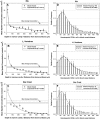Spatial gradients of blood vessels and hematopoietic stem and progenitor cells within the marrow cavities of the human skeleton
- PMID: 19749092
- PMCID: PMC2774549
- DOI: 10.1182/blood-2008-12-192922
Spatial gradients of blood vessels and hematopoietic stem and progenitor cells within the marrow cavities of the human skeleton
Abstract
This report evaluates the spatial profile of blood vessel fragments (BVFs) and CD34(+) and CD117(+) hematopoietic stem and progenitor cells (HSPCs) in human cancellous bone. Bone specimens were sectioned, immunostained (anti-CD34 and anti-CD117), and digitally imaged. Immunoreactive cells and vessels were then optically and morphometrically identified and labeled on the corresponding digital image. The distance of each BVF, or CD34(+) or CD117(+) HSPC to the nearest trabecular surface was measured and binned in 50-microm increments. The relative concentration of HSPCs and BVFs within cancellous marrow was observed to diminish with increasing distance in the marrow space. On average, 50% of the CD34(+) HSPC population, 60% of the CD117(+) HSPC population, and 72% of the BVFs were found within 100 microm of the bone surfaces. HSPCs were also found to exist in close proximity to BVFs, which supports the notion of a shared HSPC and vessel spatial niche.
Figures


References
-
- Zhang J, Niu C, Ye L, et al. Identification of the haematopoietic stem cell niche and control of the niche size. Nature. 2003;425(23):836–841. - PubMed
-
- Calvi LM, Adams GB, Weibrecht KW, et al. Osteoblastic cells regulate the haematopoietic stem cell niche. Nature. 2003;425(23):841–846. - PubMed
-
- Sugiyama T, Kohara H, Noda M, Nagasawa T. Maintenance of the hematopoietic stem cell pool by CXCL12-CXCR4 chemokine signaling in bone marrow stromal cell niches. Immunity. 2006;25(6):977–988. - PubMed
-
- Xie Y, Yin T, Wiegraebe W, et al. Detection of functional haematopoietic stem cell niche using real-time imaging. Nature. 2009;457(1):97–101. - PubMed
-
- Nilsson SK, Dooner MS, Tiarks CY, Weier HU, Quesenberry PJ. Potential and distribution of transplanted hematopoietic stem cells in a nonablated mouse model. Blood. 1997;89(11):4013–4020. - PubMed
Publication types
MeSH terms
Substances
Grants and funding
LinkOut - more resources
Full Text Sources
Other Literature Sources
Medical

